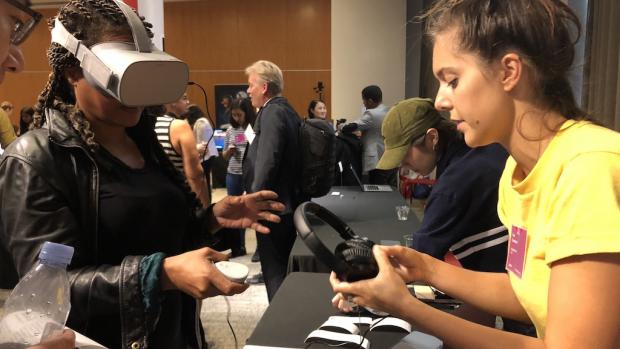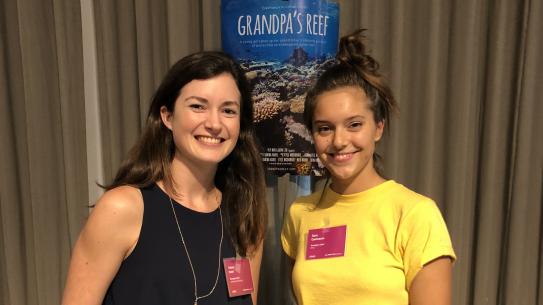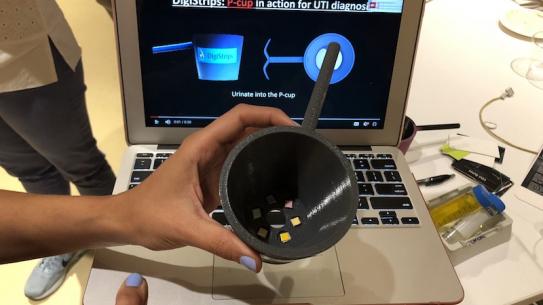Tandon-made virtual reality project wins first prize at NYC Media Lab Summit
Summit features student and faculty-designed projects in biotech, virtual reality

Sara Camnasio helps a visitor use the VR headset to view her VR film "Grandpa's Reef" at the NYC Media Lab Summit.
Virtual reality. Machine learning. Biotech. These may be the buzzwords of the tech industry, but students across New York universities are currently exploring the intersection of these emerging technologies and media in their research projects and entrepreneurial ventures. Many of these projects took center stage at the NYC Media Lab 2018 Summit and Demo Expo on September 21.
Over 100 demos, ranging from mobile augmented reality apps to innovative biomedical designs, demonstrated the diversity of ideas developed within schools like NYU Tandon School of Engineering. Held at The New School, the Demo Expo featured interactive presentations of student and faculty-designed prototypes and startups to the hundreds of attendees professionals who come to see the latest discoveries.
The NYC Media Lab, the consortium of universities and partners of which NYU Tandon is a part, awarded $25,000 in monetary prizes to the top projects, with the first prize going to the NYU Tandon-made venture, Relevant Motion.
Combining motion capture technology with a virtual reality platform, Relevant Motion provides low-cost, in-home and in-clinic occupational therapy — allowing patients to take charge of their physical rehabilitation progress. Developed by Todd Bryant, adjunct professor of the “Bodies in Motion” course within NYU Tandon Integrated Digital Media (DM), Relevant Motion features other NYU Tandon team members including Kat Sullivan (adjunct professor at IDM), Spencer Cappiello ’18, Najma Dawood ’18, and Claire Kearney-Volpe (adjunct professor at IDM).
Behind many Tandon projects at the Summit were women engineers, technologists, and data scientists. Dean Jelena Kovačević took to the Summit’s mainstage to emphasize Tandon’s commitment to gender equality in STEM, and shared with the audience that 43 percent of the incoming class is female at Tandon.
Our students, alumni, and faculty shared designs and prototypes they’ve been tinkering away at, including new ventures and labors of love developed over a few years. Here, we highlight a few demos that show that ideas made at NYU Tandon can impact our communities locally and globally.

Ocean Advocacy through VR
Taking advocacy to the next level through VR is the under-the-sea VR experience “Grandpa’s Reef.” Funded by the National Geographic Young Explorers Collaboration Grant, Sara Camnasio ’18 and her fellow Young Explorers collaborated to create a VR film that transports viewers to a healthy, vibrant coral reef. “Grandpa’s Reef” centers on increasing ocean advocacy in young Filipinos by showing the beauty of reefs and ocean conservation. The film will debut in the Philippines in 2019. “The Philippines has some of the most pristine coral reefs on the planet and virtual reality can take you there,” Camnasio said. “It’s incredibly exciting to work directly with local communities and inspire the next generation of ocean advocates.”

Instant Healthcare
An over-the-counter digital platform called Digistrips can quickly detect urinary tract infections (UTIs), and connects patients with virtual health practitioners who can treat and prescribe medicine. Digistrips merges together the healthcare and biomedical expertise from Tandon Chemical and Biomolecular doctoral candidate Deniz Vurmaz, Tandon’s Sayli Modak ’15, NYU College of Dentistry’s Shruti Warhadpande, and NYU Langone’s Sofia Bakogianni. Borne out of the NYU I-Corps Site Summer Program, Digistrips accelerates the diagnosis process for UTIs by using an urination cup coated with biosensors that connects to an application that serves as digital analyzer and virtual healthcare platform. “I’ve suffered from UTIs since I was 5 years old and I know how painful it is, and how important instant solutions are rather than waiting at a hospital and dealing with high costs,” Vurmaz said. “I thought, if I have this problem, other people do too, and deserve better solutions. The working mechanism of Digistrips is ‘test, track, treat at home.’ We aim to create more convenience for patients.”

See, Hear, Feel
Combining the aural, the visual, and the physical, the interactive art installation Audio Odyssey creates a visual representation of a person’s gestures while mapping sounds and beats to each movement. IDM student Tamanda Msosa developed Audio Odyssey as a way of blending his two loves, music and programming. Using Leap Motion, Msosa’s installation allows for tactile interaction between human and computer, with the added effect of sound. “I believe tech should help enhance our interaction with the things around us with the least amount of intrusion,” Msosa shared.




